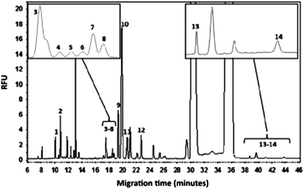Analysis of amino acids, proteins, carbohydrates and lipids in food by capillary electromigration methods: a review
Abstract
A review of the literature covering the evolution of amino acid, protein, lipid and carbohydrate analysis in food samples by electromigration techniques over the last 20 years is presented. The manuscript summarizes different modes, including capillary zone electrophoresis, micellar electrokinetic chromatography, capillary electrochromatography, capillary gel electrophoresis, capillary isotachophoresis, non-aqueous (or nonaqueous) capillary electrophoresis, capillary isoelectric focusing and microfluidic chip electrophoresis, employing different detection systems, such as ultraviolet-visible absorption, laser-induced fluorescence, mass spectrometry, amperometric detection, and capacitively coupled contactless conductivity detection. Briefly, the present review evidences that CE is a very interesting analytical separation technique for food analysis, offering short analysis times and versatility in a simple sample preparation step as inherent advantages compared to classical chromatographic methodologies, which make it a separation technique that is very attractive for quality control in industry and government agencies.

- This article is part of the themed collection: Analytical Chemistry in South America

 Please wait while we load your content...
Please wait while we load your content...